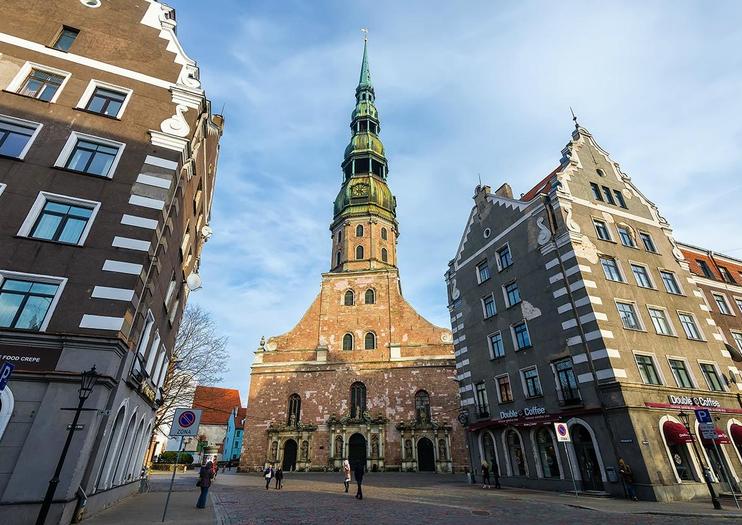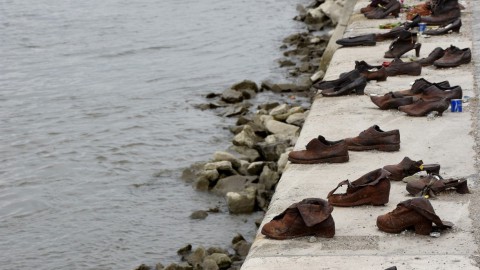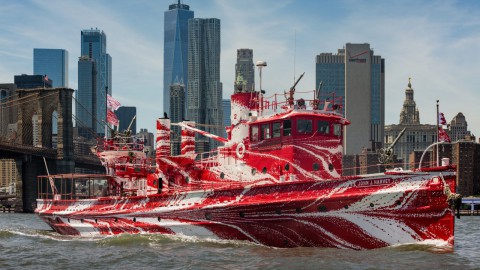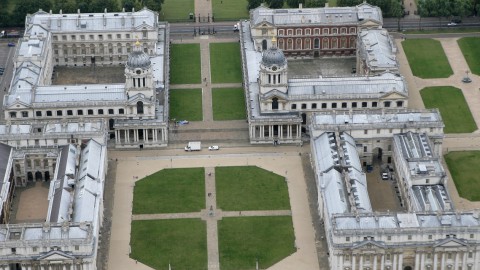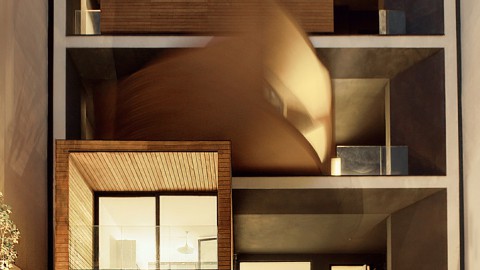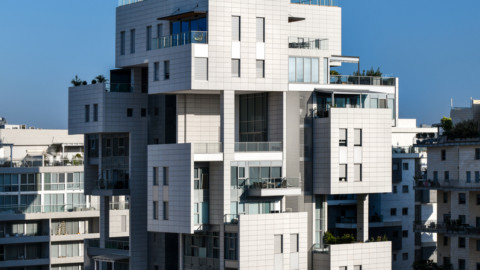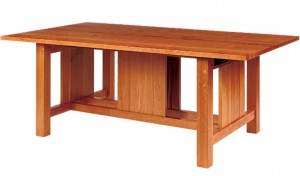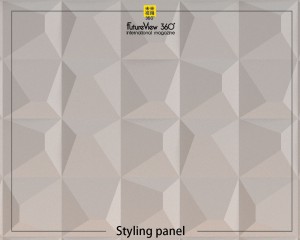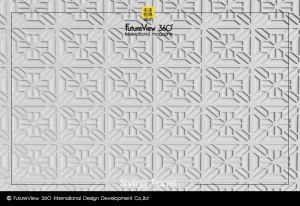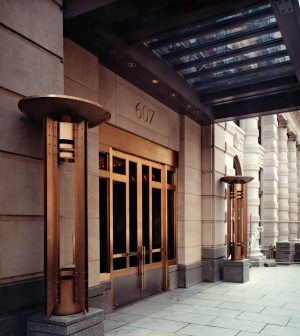St. Peter’s Church, Riga 裡加聖彼得教堂
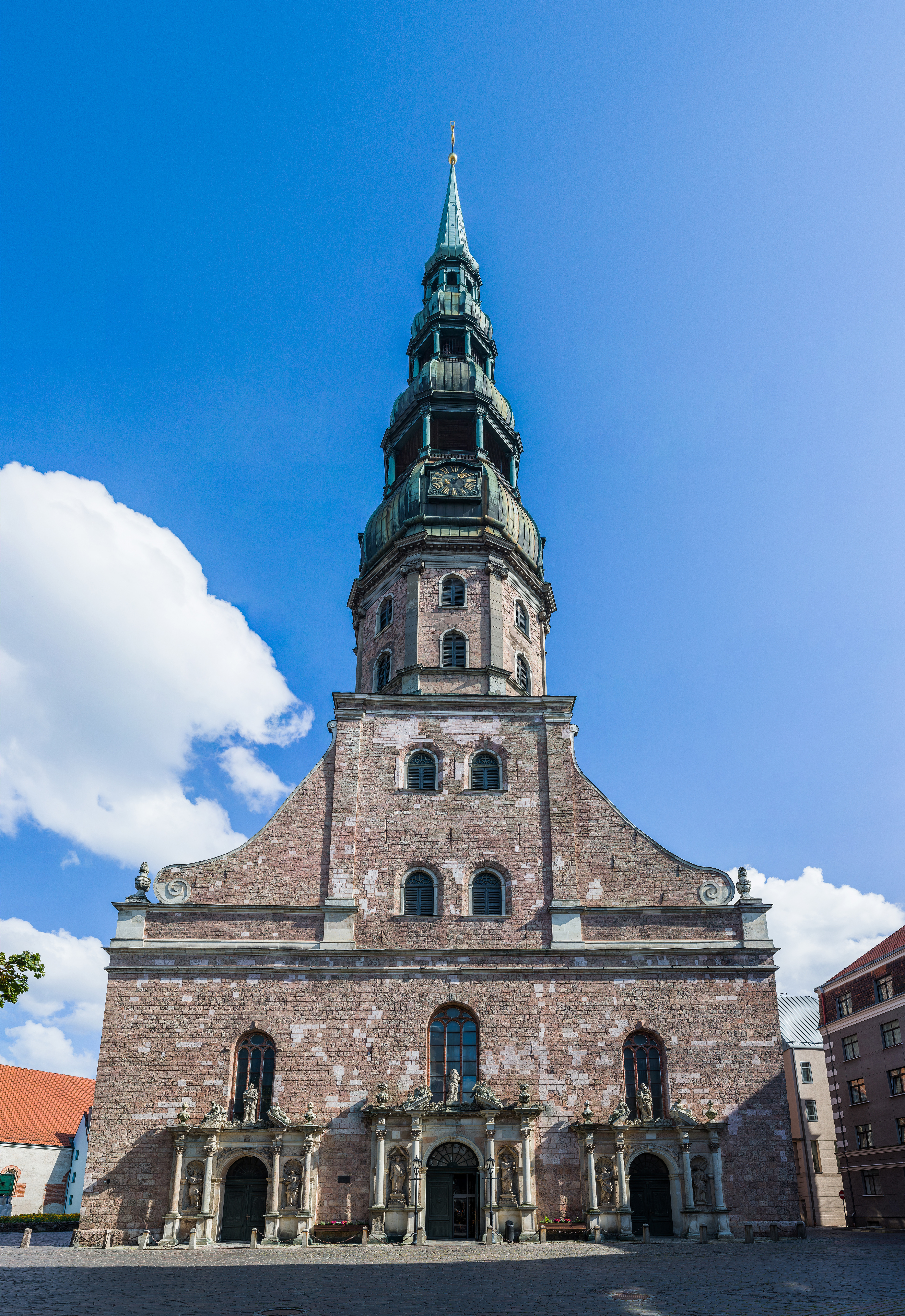
St. Peter’s Church (Latvian: Svētā Pētera Evaņģēliski luteriskā baznīca) is a Lutheran church in Riga, the capital of Latvia, dedicated to Saint Peter. It is a parish church of the Evangelical Lutheran Church of Latvia.
聖彼得教堂(拉脫維亞語:SvētāPēteraEvaņģēliskiluteriskābaznīca)是拉脫維亞首都裡加的一個路德教會,致力於聖彼得。 它是拉脫維亞福音派路德教會的教區教堂。
Location:Riga
Country:Latvia
Denomination:Lutheran
Previous denomination:Roman Catholic
Administration
Archdiocese:Riga
Clergy
Archbishop:Jānis Vanags
Pastor(s):Atis Vaickovskis
位置:裡加
國家:拉脫維亞
面額:路德
以前的面額:羅馬天主教
管理
大主教管區:裡加
牧師
大主教:JānisVanags
牧師:Atis Vaickovskis
History
First mention of the St. Peter’s Church is in records dating to 1209. The church was of masonry construction and therefore undamaged by a city fire in Riga that year. The history of the church can be divided into three distinct periods: two associated with Gothic and Romanesque building styles and the third with the early Baroque period. The middle section of the church was built during the 13th century, which encompasses the first period. The only remnants of this period are located in the outer nave walls and on the inside of a few pillars in the nave, around which larger pillars were later built.
Second period of construction
The second period dates to 1408–09, when master builder Johannes Rumeschottel from Rostock supervised the construction of the sanctuary, based on the St. Mary’s Church in Rostock. The sanctuary was almost finished by 1409, but due to the Polish–Lithuanian–Teutonic War it was completed and dedicated only in 1419. Other construction work was interrupted by the plague in 1420 and resumed in the 1430s. The 13th-century church was reconstructed in 1456–66 to conform to the newly built sanctuary. Both constructions were joined in the 1470s, thereby creating a mighty basilica with three aisles and ornate vaulted ceilings. The old bell tower was replaced in 1456, and a bell was hung in the new tower in 1477. A 136 metres (446 ft) octagonal steeple was added to the tower in 1491, which, along with the church’s front facade, dominated the silhouette of Riga. The tower collapsed 11 March 1666, destroying a neighboring building and burying eight people in the rubble. The cornerstone for a new tower was laid 29 June 1667.
Third period of construction
The third period of construction dates to 1671–90, with the construction of the western facade and the new tower. The roof, vaulted ceilings and furnishings were also renovated during this time. Jacob Josten, the Dutch-born master builder of Riga, designed the tower and supervised its construction, which was begun April 1671 by the master mason Heinrich Henicke. Josten was replaced in 1675 by Rupert Bindenschu (1645–1698), the next master builder of Riga. The tower was completed in 1677, but it, along with the church interior, were destroyed already 21 May 1677, during a citywide fire. Bindenshu supervised the subsequent repairs in 1677–79: vaulted wooden ceilings replaced the former masonry vaulted ceilings, and the roof, windows, interior and furnishings were replaced or renovated. First service in the renovated church took place 14 September 1679. Renovation of the tower began 1686 and was designed by the city engineer Friedrich S. von Dahlen. The city council did not approve of the half-finished steeple, and so it was torn down in 1688. A new 148 metres (486 ft) copper-roofed steeple, designed by Bindenshu, was then built. A sphere and rooster were set atop the steeple 10 May 1690. This tower was the tallest wooden construction in Europe at the time. The western facade of the church was also altered in the later 17th century. The brick construction was covered with reddish limestone from Salaspils and Koknese, and the facade was decorated with volutes, pilasters, cornices, vases and borders made of Gotland stone. In 1692 the Riga City Council approved a design by Bindenshu and the mason Andreas Peterman for three identical portals. The merchant Klaus Mistett financed the portals, which were built by H. Henneken, Johann Daniel Schauss, Johann Gerwin and several other sculptors. The portals were decorated with Baroque style limestone sculptures. In 1694 L. Martini installed a new tower clock with a glockenspiel from Amsterdam.
歷史
第一次提到聖彼得教堂的記錄可以追溯到1209年。教堂是砌築建築,因此當年沒有受到裡加城市火災的影響。教堂的歷史可以分為三個不同的時期:兩個與哥特式和羅馬式建築風格相關,第三個與早期的巴洛克時期相關。教堂的中間部分建於13世紀,包括第一個時期。這一時期唯一的殘餘物位於教堂中殿的外部中殿壁和內部的幾根柱子的內部,後來圍繞這些柱子建造了更大的柱子。
第二期建設
第二個時期可以追溯到1408-09,當時羅斯托克的建築大師Johannes Rumeschottel根據羅斯托克的聖瑪麗教堂監督建造聖所。庇護所差不多完成了1409年,但由於波蘭 – 立陶宛 – 條頓戰爭它完成並且僅在1419年完成。其他建築工作在1420年被瘟疫打斷並在1430年代恢復。這座13世紀的教堂於1456年至1966年重建,以符合新建的聖殿。兩座建築都是在1470年代加入的,從而形成了一座擁有三個過道和華麗拱形天花板的強大教堂。 1456年更換了舊鐘樓,並於1477年在新塔樓懸掛了鐘.1491年,塔樓增加了一個136米(446英尺)的八角形尖塔,與教堂的正面立面一起佔據了主導的輪廓。裡加該塔於1666年3月11日倒塌,摧毀了一座鄰近的建築物,並將8人埋在瓦礫中。 1667年6月29日奠定了新塔的基石。
第三期建設
第三期建設時間為1671 – 90年,建造了西立面和新塔。在此期間,屋頂,拱形天花板和家具也進行了翻新。荷蘭出生的里加主建築師雅各布·喬斯滕(Jacob Josten)設計了這座塔並監督了它的建造,該建築於1671年4月由大師梅森海因里希·亨尼克(Heinrich Henicke)開始。喬斯滕於1675年由里加的下一位建築大師魯珀特·賓德丘(Rupert Bindenschu,1645-1698)取代。該塔於1677年完工,但它與教堂內部一起於1677年5月21日在全市範圍的火災中被摧毀。 Bindenshu監督了1677年至1979年的後續修繕:拱形木質天花板取代了以前的磚石拱形天花板,屋頂,窗戶,內部和家具被更換或翻新。經過翻新的教堂的第一次服務於1679年9月14日進行。塔樓的改造始於1686年,由城市工程師Friedrich S. von Dahlen設計。市議會不贊成半成品的尖頂,因此它在1688年被拆除。然後建造了一個由Bindenshu設計的新的148米(486英尺)銅屋頂尖頂。 1690年5月10日,一座球體和一隻公雞被放置在尖頂上。這座塔樓是當時歐洲最高的木結構建築。教堂的西立面在17世紀晚期也有所改變。磚結構覆蓋著來自Salaspils和Koknese的紅色石灰岩,外立面裝飾有蝸殼,壁柱,飛簷,花瓶和哥特蘭石製成的邊框。 1692年,裡加市議會批准了Bindenshu和泥瓦匠Andreas Peterman為三個相同的門戶網站設計的設計。商人Klaus Mistett資助了由H.Henneken,Johann Daniel Schauss,Johann Gerwin和其他幾位雕塑家建造的門戶網站。門戶裝飾有巴洛克風格的石灰石雕塑。 1694年,L。Martini用阿姆斯特丹的鍾琴安裝了一個新的塔鐘。
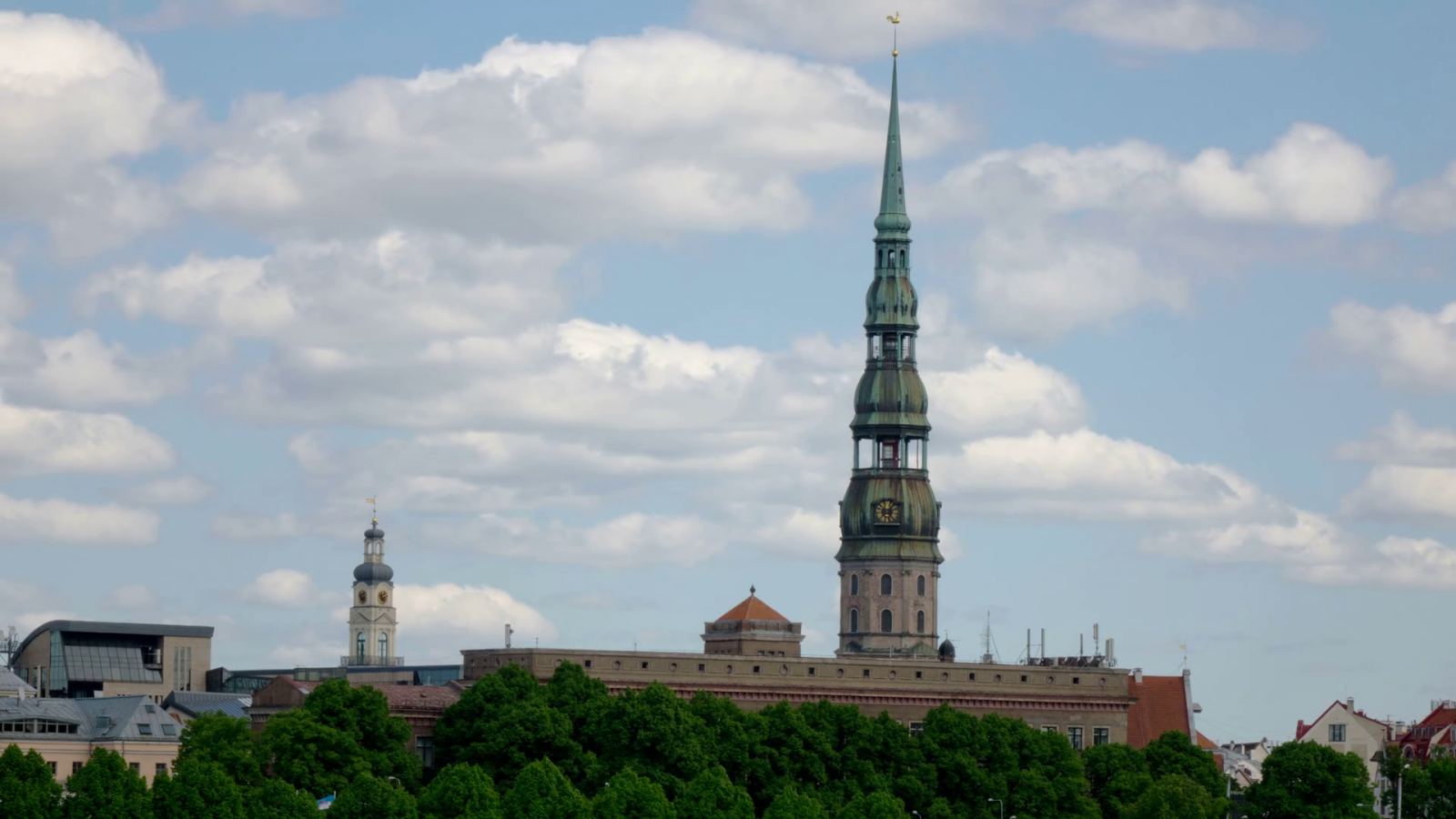
First reconstruction
The newly renovated church served for a mere 29 years, for lightning struck and set fire to the tower and church 10 May 1721. Only the church and tower walls remained standing after the fire. Reconstruction of the church began immediately under the direction of the master carpenter Tom Bochum and master mason Kristofer Meinert. By 1723 the building already had a temporary roof. Johann Heinrich Wilbern took over supervision of the project in 1740, and under his direction a new 120.7 metres (396 ft) steeple was built in 1746. The steeple was covered with copper-plate and the rooster was gilded in 1746–47. Christoph Haberland designed a new marble pulpit for the church, which was built in Italy in 1793. In 1794 Haberland renovated the wooden vaulted ceilings in the central sections of the nave. The interior walls were plastered and the lower sections of the pillars were covered with oak panels in 1885 under the direction of architect Reinhold Georg Schmaeling (1840–1917).
Second reconstruction
Artillery fire destroyed the church on 29 June 1941. Conservation and restoration began 1954 with research by architect Pēteris Saulītis. The work was carried out from 1967 to 1983 under the direction of Saulītis and architect Gunārs Zirnis. Renovation began with the metal tower frame. A rooster – a precise reproduction of the previous rooster and the seventh rooster in all – was placed atop the steeple 21 August 1970. The renovated tower clock began to show time in July 1975. According to tradition, it has only an hour hand. The bell music began in 1976; it plays the Latvian folk melody “Rīga dimd” five times a day and bells ring at the top of every hour. The tower has an elevator installed that allows visitors a view of Riga from a height of 72 metres (236 ft). Renovation of the interior of the church ended in 1984. The Polish company “PKZ” restored the main facade and portals in 1987–91. The St. Peter’s Latvian Lutheran congregation resumed services in the church 1991, and the church was returned to the ownership of the Evangelical Lutheran Church of Latvia on 4 April 2006.
During World War II, the church lost an important object of cultural heritage – an impressive bronze candelabrum made in 1596 – which was taken to the town of Włocławek by Germans from Riga, resettled during “Heim ins Reich” action to annexed Polish territories. The 310 cm high and 378 cm wide candelabrum, previously called a standing lantern, was ordered by the City Council of Riga from the metal founder Hans Meyer’s Riga foundry. After the war, it was displayed in Włocławek’s Basilica Cathedral of the St. Mary of Assumption. On 1 March 2012 this piece of the Late Renaissance art returned to its ancient home, as a result of an agreement on the repatriation of cultural properties. The statue of the rooster on the top of the church weighs 158 kg and 140 grams of gold were used to gold plate the statue.
第一次重建
新裝修的教堂僅用了29年,因為閃電擊中並在1721年5月10日放火燒毀塔樓和教堂。只有教堂和塔樓牆壁在火災後仍然存在。教堂的重建立即在木匠湯姆波鴻和大師梅森克里斯托弗梅內特的指導下開始。到1723年,該建築已經有了一個臨時屋頂。約翰·海因里希·威爾伯恩於1740年接管了該項目的監督,並在他的指導下,在1746年建造了一個新的120.7米(396英尺)的尖頂。尖頂上覆蓋著銅板,公雞在1746年至47年間鍍金。 Christoph Haberland為教堂設計了一個新的大理石講壇,於1793年在意大利建造。1794年,Haberland修復了教堂中央部分的木製拱形天花板。 1885年,在建築師Reinhold Georg Schmaeling(1840-1917)的指導下,內牆被抹灰,柱子的下半部分被橡木板覆蓋。
第二次重建
1941年6月29日,炮火摧毀了教堂。保護和修復始於1954年,由建築師PēterisSaulītis進行研究。這項工作是在Saulītis和建築師GunārsZirnis的指導下於1967年至1983年進行的。裝修始於金屬塔架。 1970年8月21日,一隻公雞 – 精確複製了以前的公雞和第七隻公雞 – 被放置在尖頂上。經過翻新的塔鐘於1975年7月開始顯示。根據傳統,它只有一小時的時間。鈴聲始於1976年;它每天五次播放拉脫維亞民間旋律“Rīgadimd”,鈴聲響起,每小時播放一次。塔樓安裝了電梯,可讓遊客從72米(236英尺)的高度欣賞裡加。教堂內部的翻新於1984年結束。波蘭公司“PKZ”於1987年至1991年恢復了主立面和門戶。聖彼得的拉脫維亞路德教會會堂於1991年恢復了教堂的服務,教堂於2006年4月4日歸還拉脫維亞福音派路德教會。
在第二次世界大戰期間,教堂失去了一個重要的文化遺產 – 一座1596年製造的令人印象深刻的青銅燭台 – 由里加的德國人帶到Włocławek鎮,在“Heim ins Reich”行動中被重新安置到吞併波蘭領土。裡加市議會從金屬創始人Hans Meyer的里加鑄造廠訂購了310厘米高,378厘米寬的大燭台,以前稱為立燈。戰爭結束後,它在Włocławek的聖母升天大教堂舉行。 2012年3月1日,由於就文化財產的遣返達成協議,這件文藝復興晚期藝術作品回歸其古老的家園。教堂頂部的雄雞雕像重達158公斤,並用140克黃金鍍金雕像。
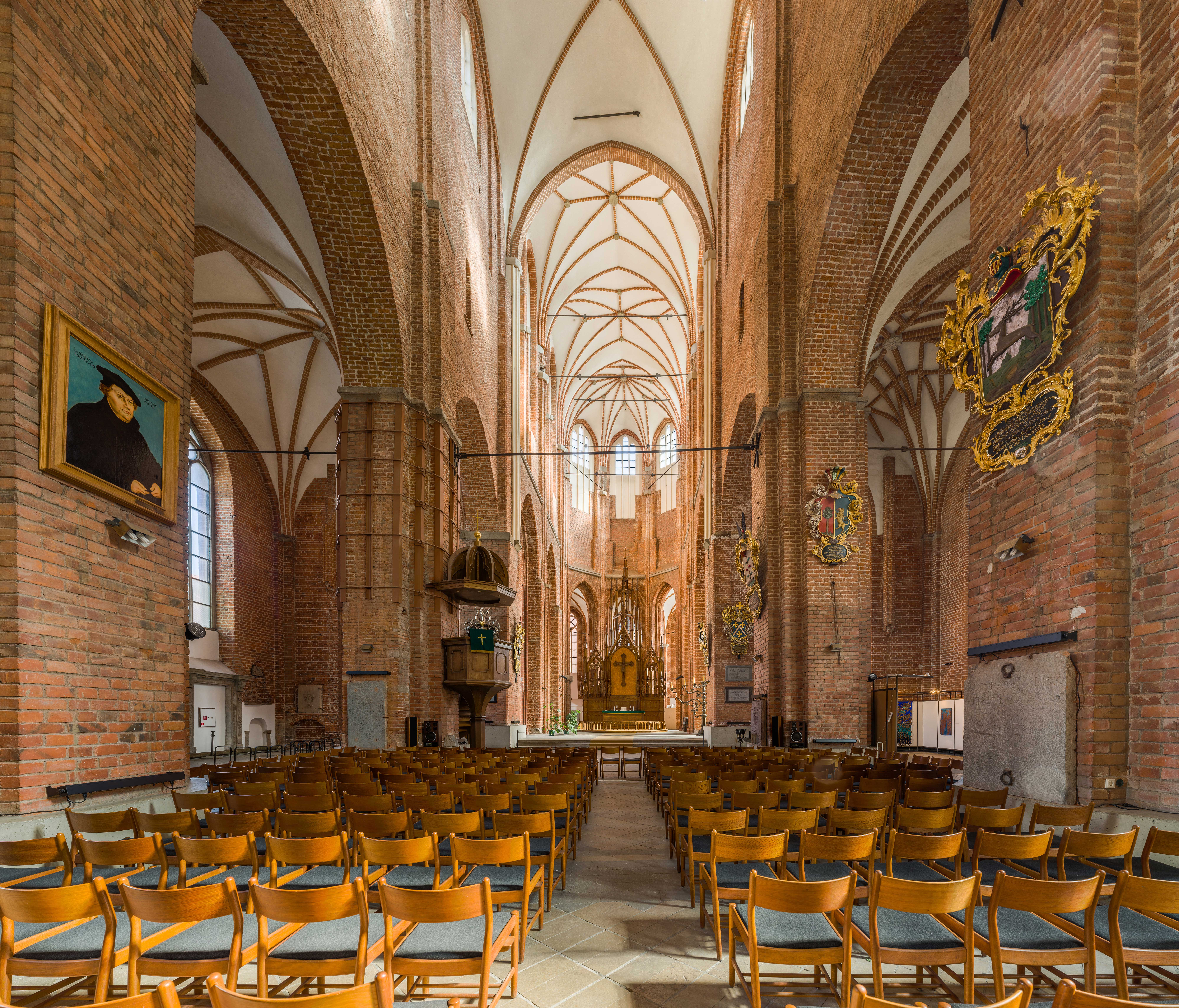

FROM:https://en.wikipedia.org/wiki/St._Peter%27s_Church,_Riga
FROM:St. Peter’s Church – Riga, Latvia
FROM:4K Riga. St. Peter’s Church.Latvia. Manual control
Don’t you think it’s addictive?
Want to know more about the beauty of architecture?
Come and join our members to explore the beauty of architectural design.
覺得看得不過癮嗎?
想要知道更多建築之美嗎?
快來加入我們的會員,一同探索建築設計之美。
The above article is purely for appreciation and sharing purposes, as well as the construction of new technology and the public can be in-depth understanding of the information at the same time there are sources, will be able to query, no use of the document as a commercial transaction, if illegal, please inform the We will immediately remove the site, thank you for cooperation.
以上文章純粹作為欣賞及分享用途,以及將建築新型技術傳遞給與大眾能夠深入了解,同時資料還有來源,將可查詢,絕無使用該文件資料作為商業交易行為,如有違法請務必告知該網站我們將立即處理撤除,謝謝合作。

